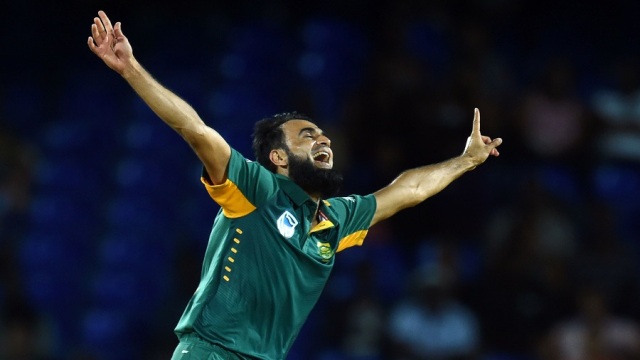Imran Tahir should have been one of the first names on the ODI Team of the Year list.
The ICC Teams of the Year can be misleading if you weren’t aware that the period counted is actually between 14 September 2015 to 20 September 2016.
Virat Kohli’s exclusion from the Test side, for instance, makes more sense when you take away his double hundreds. If you’re Adam Voges, a calendar year average of 38 becomes an absurd 90 in the ICC window. In fact, there’s probably no batter more deserving to be in the Test side based on that period.
But that’s if you’re going purely by stats. So if the judging panel, comprised of Gary Kirsten, Rahul Dravid and Kumar Sangakkara, did go by stats, then it’s a crying shame that Imran Tahir has to carry the hypothetical drinks by being named as 12th man.
The stats will tell you that he’s taken more wickets than any other bowler in ODI cricket in that period. He took an excellent 28 scalps from 16 matches at an average of 27.14. The spinners that got the job ahead of him were Indian all-rounder Ravindra Jadeja and West Indian mystery spinner Sunil Narine.
The judges factored in averages for a lot of the selections, and it’s becoming an increasingly important stat due to the increasing disparity in Tests played between nations. England, for example, have played nine more Tests than the Proteas this year. That’s why we still get to see Dale Steyn in the Test team of the year – His 14 wickets from four matches came at an average of 15. A Test Championship would sort out this nonsense, but that’s an argument for another time.
My point is, that’s why Narine got selected ahead of Tahir. Jadeja is probably in there for his usefulness with the bat at No 8. But Narine’s 16 wickets from 10 matches came at an average of 22.31, with a considerably better economy rate than Tahir’s. What they seem to have overlooked however is the strike rate. Tahir took more wickets per balls than Narine, and that’s exactly what you want as a captain – a leg-spinner constantly looking to attack.
If you find this all a bit frivolous, instead just take a moment to appreciate Tahir’s efforts in this format over the past year and a bit.
It’s been a largely successful period in the 50-over format for the Proteas, and boasting world-class options with the ball, Tahir is always right up there in the wicket-taking charts. His 7-45 in the Tri-Nation series against West Indies in June was one of the great performances in world cricket this year. They were the best figures by a South African in ODI history and the ninth-best of all time. In that spell he also became the quickest South African and fifth-quickest of all time to reach 100 ODI wickets.
After being dropped from the Test side pretty much for good towards the end of last year, he’s had to make an impact in the shorter formats to stay relevant in the international arena, and at 37 years old that’s no easy task. If personality and fight were attributes included in the ICC’s judgment, then Tahir would have waltzed into the team.
He celebrates each wicket as if it’s his last. ‘He’s an absolute go-to man,’ Faf du Plessis said after the whitewash victory against Australia. ‘He’s the reason why we are where we are.’
And who can forget his heated exchange with David Warner in the fifth ODI? ‘I only get aggressive if the opponent says something to me that requires me stand up for myself, and that’s exactly what happened at Newlands,’ he told me a couple of weeks ago. ‘Things are fine now, but if I see him again I’ll remind him that he owes me 40% of his match fee!’
He didn’t even give the Boks mercy in the Legacy Cup. Every ball he bowled was as good as any ball he’s bowled for the green and gold all year. That’s just the nature of his competitive spirit.
He may not have cracked the nod for the ODI world XI, but, in a year in which many consider to be the one of the worst in recent memory, Imran Tahir can toast to what has been one of his best. A can of coke or a glass of water, of course.





